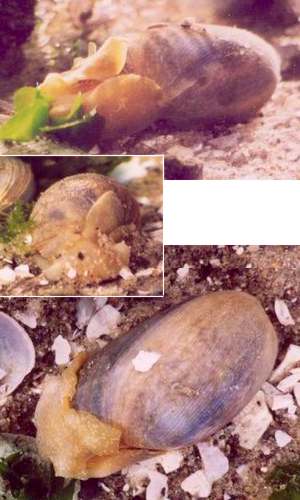
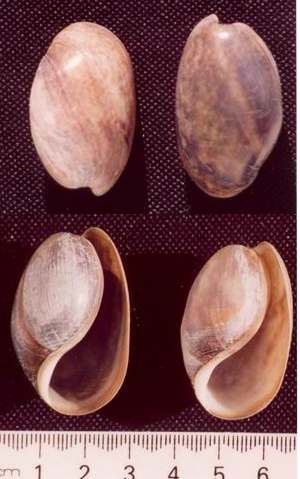
Bulla quoyii
Gray in Dieffenbach, 1843
Order: CEPHALASPIDEA
Family: Bullidae
DISTRIBUTION
New Zealand - North Island, and extreme north of South Island. Australia - temperate regions from central New South Wales to Western Australia.
PHOTO
Tauranga Harbour, New Zealand, July 2003. Photo: Paul Furneaux.
The heavily calcified external shell, can be mottled with various shades of brown, but is often a fairly uniform greyish brown. There are strong spiral grooves around the base of the shell. The animal is similar in shape to that of Bulla ampulla with the posterior edge of the head shield deeply cleft to form a pair of large flaps which partially cover the leading edge of the shell. The anterior corners of the head shield are developed into prominent enrolled tentacles which channel water down each side of the head over the chemosensory Hancock's Organs. The animal is a bright yellow-orange with paler mottlings.
This animal seems to be an intertidal species, or at the most extending into the shallow sub-littoral. Populations can be found on a variety of sheltered shores, from silty mud to coarse shell sand, and at times to rocky intertidal platforms covered with coralline algal turf. It feed primarily on filamentous green algae, but sometimes will also eat Ulva. It also appears to scrape the diatomaceous film off the leaves of sea-grasses. The spawn is very recognisable. It consists of an ovoid blob filled with jelly-like mucus in which the eggs are arranged in a spiral string. The eggs are an orange-red colour. The animal grows to about 60mm in length.
References:
• Rudman,W.B.(1971). Structure and functioning of the gut in the Bullomorpha (Opisthobranchia). Part 1. Herbivores. Journal of Natural History, 5: 647-675.
• Willan, R.C. (1978) The nomenclature of three Pacific Bulla species. Journal of the Malacological Society of Australia, 4(2): 57-68.
Rudman, W.B., 2003 (August 31) Bulla quoyii Gray in Dieffenbach, 1843. [In] Sea Slug Forum. Australian Museum, Sydney. Available from http://www.seaslugforum.net/find/bullquoy
Related messages
Re: Bulla quoyii from New Zealand
December 18, 2008
From: Graham Bould
Concerning message #10870:
I have seen quite a few Bulla quoyii, both live and shells, at low tide round the rocks east of St Heliers Bay, Auckland. They seem to like muddy coralline turf.
Graham Bould
graham@grahambould.net
Bould, G., 2008 (Dec 18) Re: Bulla quoyii from New Zealand. [Message in] Sea Slug Forum. Australian Museum, Sydney. Available from http://www.seaslugforum.net/find/22109Thanks Graham,
Best wishes,
Bill Rudman
Bulla quoyii - mass mortality
December 9, 2003
From: Paul Furneaux
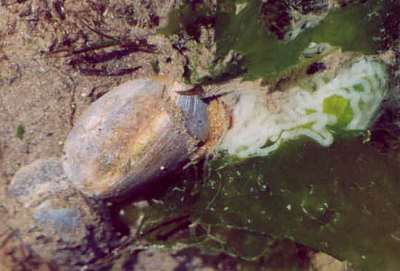
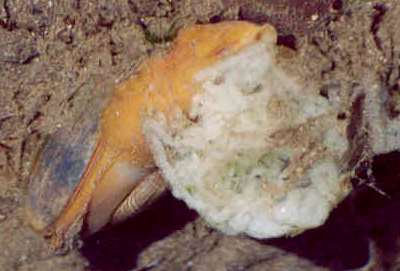
PHOTOS: Upper - Bulla laying egg string on Ulva., Centre - egg string still emerging., Lower - aquarium photo. Bulla quoyii, Tauranga Harbour, New Zealand. 21 November 2003. Photos: Paul Furneaux.
Dear Bill,
Just a few further observations on Bulla quoyii numbers during November-December here in Tauranga, NZ, to add to my earlier messages.
Early on in November the number of Bulla individuals that would be recorded in a survey increased from 8 per survey to over 200 per survey by Nov. 21st. A peak of some 1200 to 1300 animals was seen on Nov. 29th and this had fallen away to only 25 animals by Dec. 6th, with lots of dead animals and empty shells around to indicate their fate. Egg strings followed a similar pattern but tended to be ahead of the animal numbers early in November, jumping from 19 seen on Nov. 6th, to 500-600 recorded for Nov. 21st. However, because the eggs mature quite quickly (about 10 days to release veligers in the aquarium) the numbers of egg strings never quite matched the peak numbers of animals and the greatest number was recorded on Dec. 2nd at 719.
The egg strings were attached to various substrates, mostly algae, including Ulva, Enteromorpha, Gracilaria, as well as Zostera and even empty Arachnoides exoskeletons. The mating aggregations were at their largest when the density of the animals was at its greatest - groups of 10-14 animals were common on Nov. 29th but not on other occasions. By the look of the current trend in numbers the breeding activity for Bulla in this area will be over by the end of December.
I've attached photos of animals that appear to be in the process of depositing egg strings together with a shot of one of my aquarium animals just prior to its release. (it was quite co-operative and had perhaps become used to having lights on it at any time of the day)
Regards,
Paul Furneaux.
P.Furneaux@xtra.co.nz
Furneaux, P., 2003 (Dec 9) Bulla quoyii - mass mortality. [Message in] Sea Slug Forum. Australian Museum, Sydney. Available from http://www.seaslugforum.net/find/11632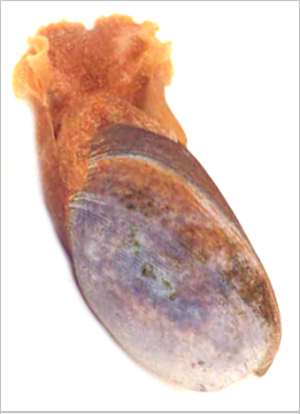
Dear Paul,
Thanks for this information. I think this definitely counts as a mass mortality event, much as occurs in many species of Sea Hare. It has all the classic features - apparent sudden appearance of many adults, much breeding activity, then sudden death of most of the population. This type of phenomenon has led to speculation about sea slugs migrating to specific breeding grounds. My feeling is that rather than migrating to a particular place, these animals are a local population that has remained unobserved as they grew because of camouflage, and/or behaviour, which made them difficult to see. In the case of Bulla quoyii I suspect juveniles and sub-adults live in the upper layers of the sandy/mud only emerging at night for feeding. When they reach full size and breeding activity begins, they begin to stay on the surface for long periods and so both the animals and their egg strings become suddenly visible. Mass mortality would also explain why at times, large numbers of empty shells can be found, but not a single live animal.
Best wishes
Bill Rudman
RE: Bulla quoyii - breeding observations
November 19, 2003
From: Rachel Przeslawski
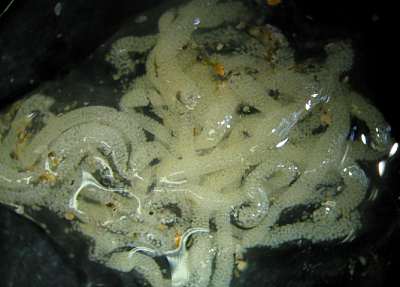
Paul's recent description of Bulla quoyii egg masses sounded quite familiar. In Feb 2003, I collected what looked like a completely white Aplysia egg mass under a boulder near some algae in Wollongong. Usually when these egg masses are so pale, it is a sign that they have hatched or are completely inviable. However, when I examined the eggs in this mass under the microscope, I found that almost all of them were developing quite happily, 1 to each capsule.
Of course I can't be certain this egg mass belongs to Bulla quoyii, but the similarities to Paul's description match quite well. I have never seen adults in the area, and I have never seen its egg masses again. However, I find Bullina lineata in this area with some frequency... do these two species share the same habitat?
Cheers
Rachel
rachelp@uow.edu.au
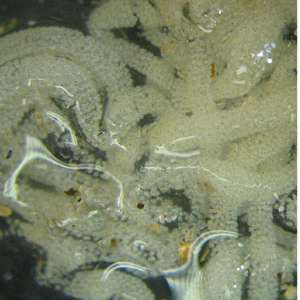
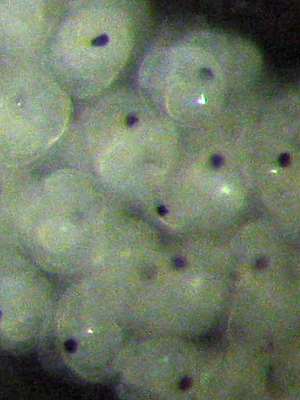
Thanks Rachel,
Your eggs could well be those of Bulla. Bullina lineata, like its larger relative, Hydatina physis are found on both rocky reefs and soft shores so there is no real reason why Bullina and Bulla could not be found together.
Best wishes
Bill Rudman
Bulla quoyii - breeding observations
November 18, 2003
From: Paul Furneaux
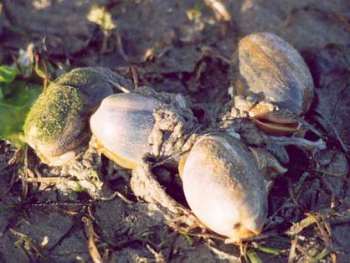
Upper Photo: breeding aggregation.
Lower Photos: showing egg strings and animal laying an egg string.
Dear Bill,
At last Bulla quoyii has been in action in a fairly spectacular way here in Tauranga [New Zealand]. As you know I've been keeping an eye on its activities as part of my Royal Society Teacher Fellowship and during this month (November) it has begun its reproductive cycle with gusto. Prior to this month I would record beteween 5-10 individuals from an area of about 14,000 sq.m, but during the last week on three separate visits I have recorded from 25-270 individuals from a smaller area of 5,600 sq.m, an area that was used by Aplysia juliana earlier in the year for its reproductive purposes. The most exciting thing for me is to see their egg strings, from 95-230 per visit so far. These egg strings are reminiscent of the Aplysia egg strings but are smaller in volume (about 5cm by 5cm by 2cm) and a pale white to cream in colour. Each string is about 2mm in diameter and contain a spiral string of capsules which under the microscope show one embryo per capsule (unlike the Aplysia strings which seem to have from 20-40 embryos per capsule) Each capsule is about 300um in diameter and the 2-day old embryos were about 125um in diameter. Within 7-8 days the capsules contain active veligers and these may possibly be released after 2 weeks (yet to confirm)
I had been expecting the sac-like egg mass with red coloured eggs as described in Willan & Morton, 1984, but these egg strings are rather different, more reminiscent of anaspidean egg strings than cephalspidean egg masses. The behaviour of Bulla in this "breeding ground" area is also interesting, they have definitely massed together within a particular area, this area being at the low tide mark with abundant Zostera, Ulva and some Enteromorpha ramulosa. Their are pools and tidal-streams surrounding the Zostera banks and other species found here include Haminoea, Atrina, Arachnoides and Chaetopteris. Often they rest in their usual half-buried pose, but in clusters of 3-6 individuals and such groups may be seen both in and out of the water at dead low tide. Their egg strings are attached to Ulva usually but also to Zostera, and in some cases their egg string was still emerging even as the animal was exposed by the receding tide, although most egg strings seem to be placed in pools that never dry out.
I hope that the photos [taken on 15 November 2003] show most of what I've described, I was so stunned by the egg strings that I kept two animals in my aquarium at home and sure enough they have obliged by producing 3 separate egg strings during the past week. Bulla has been so challenging that when something like this happens it seems too good to be true. Hope that you enjoyed your holiday in NZ.
• Willan, R. & Morton, J. (1984) Marine Molluscs. Part 2. Opisthobranchia. Leigh Marine Laboratory, University of Auckland, New Zealand.
Regards from
Paul Furneaux.
P.Furneaux@xtra.co.nz
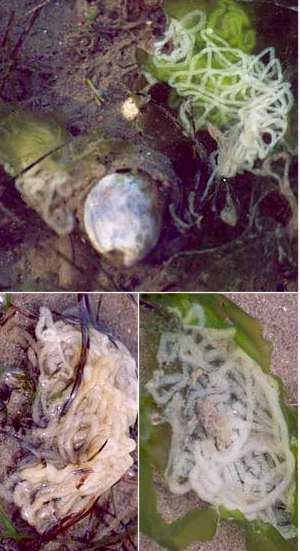
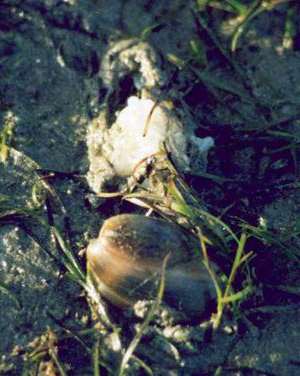
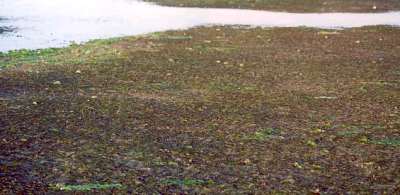
Photo: Zostera bank where Bulla were found breeding.
Dear Paul,
This is very interesting news. I have wondered about Willan & Morton's egg mass description which I suspect is that of a polychaete worm. I found egg strings like in your photos but could never positively link them to Bulla. It is really good that they obliged and produced egg strings in an aquarium for you. This egg mass is similar to that described for the North American Bulla gouldiana, and to Erwin Koehler's photos of what he suspects are the eggs of Bulla ampulla. I am glad you have been able to finish your project on such a high note.
Best wishes
Bill Rudman
Handy Hints for finding Bulla quoyii
November 14, 2003
From: Paul Furneaux
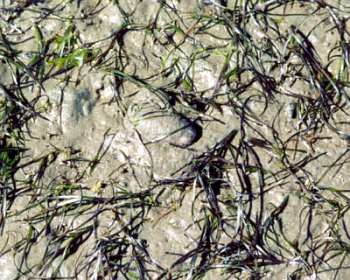
Dear Bill,
In response to Audrey Falconer's (Sept 2nd) request for "handy hints" for finding Bulla quoyii, I've included some photos of the situation that I have often encountered on the harbour flats here in Tauranga, NZ. (Sorry its taken so long to respond)
Typically the animals that I have found have been associated with Zostera (eelgrass) and were always in the low tide zone that is uncovered by the tide for perhaps one-two hours at the most. They don't seem to burrow too deeply and the reason that I have found them is that they are either "half out" of the mud, a bit like an ostrich burying its head in the sand, so that the posterior part of the shell is visible, or the outline of the shell is visible because the depth of burrowing is so shallow.
I've also included a photo of one animal that I placed on some Ulva in daylight and after some time it made a move to crawl off the Ulva to escape the light and bury itself and in so doing emerged reasonably fully from its shell. One animal that I have maintained in a tank for a few weeks is extremely active at night and devours Enteromorpha ramulosa (a green alga that is reasonably common in Tauranga Harbour), but it seems to be uninterested in eating Ulva. [Photos were taken by me on 6-7 October, 2003].
I've continued to make observations on both Haminoea and Philinopsis and will send you some of these before too long. (I'm just in the process of writing up my work and will soon have to face up to the prospect of returning to the classroom)
Regards,
Paul Furneaux.
P.Furneaux@xtra.co.nz
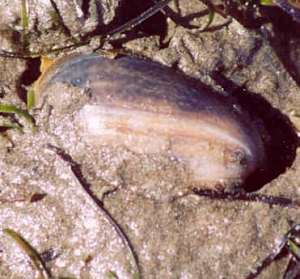
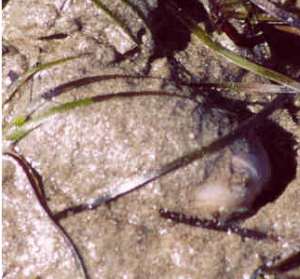
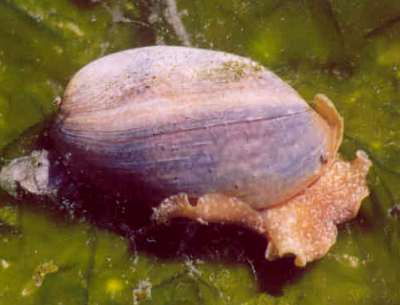
Thanks Paul,
You are certainly building up a nice picture for us of these New Zealand cephalaspideans. I hope you will still get the opportunities to continue this work when you return to teaching
Best wishes
Bill Rudman
Bulla quoyii from South Australia
September 3, 2003
From: John Chuk
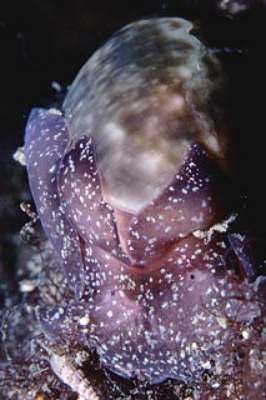
Dear Bill,
As an addition to the recent messages regarding Bulla quoyii here is a head on shot of a specimen photographed at Edithburgh Jetty, South Australia on 27th February 2001. The specimen measured about 30mm in length. At that time the species was abundant and hundreds were found at night feeding on filamentous algae growing on a large bed of ascidians on the bottom at a depth of 1.5m.
I did try placing a specimen on the sand bottom for a better shot but before I could aim the camera the specimen had half buried itself! Seconds later it completely disappeared.
The species was only seen at night. All specimens were very photophobic and would move away from a torch beam quite rapidly. I suspect specimens spend the daylight hours under rocks or buried in sediment.
I returned to the site in February 2003 and after three night dives had found a total of three small specimens. For whatever reasons some years are better than others for the local Bulla quoyii population.
I have found shells of the species at many sites in Victoria but have yet to meet a live specimen.
Best wishes,
John.
jchuk@giant.net.au
Chuk, J., 2003 (Sep 3) Bulla quoyii from South Australia. [Message in] Sea Slug Forum. Australian Museum, Sydney. Available from http://www.seaslugforum.net/find/10890Thanks John,
I certainly think the nocturnal activity of this species is one reason it is often hard to find. The other as you also suggest, is that its population cycles are very erratic, sometimes in large numbers. other times very scarce. I am also intersted in the colour of the animal in your photo. New Zealand animals are always a distinctive yellow or orange, with pale specks, never this reddish brown
Best wishes,
Bill Rudman
Re: Bulla quoyii from New Zealand
September 2, 2003
From: Audrey Falconer
Any handy hints for finding Bulla quoyii? Next March I'm going to Port Welshpool in Victoria, Australia, and one of the targets is to catch and photograph one.
Thanks for any suggestions!
Audrey
audrey@bluering.org.au
Falconer, A., 2003 (Sep 2) Re: Bulla quoyii from New Zealand. [Message in] Sea Slug Forum. Australian Museum, Sydney. Available from http://www.seaslugforum.net/find/10876Dear Audrey,
I should have included temperate Australia in to the distribution range of B. quoyii where it was for a long time known as Bulla botanica [= Quibulla botanica].
I'm afraid I am not a good person to give advice on Bulla hunting. Although I have found huge drifts of empty shells at times I have only ever found them alive in small numbers. One problem is that they seem to be nocturnal animals, spending the day either buried in the substrate or nestled in clumps of sea grass or algae. So may be a night visit at low tide may be the answer
Best wishes
Bill Rudman
Bulla quoyii from New Zealand
September 1, 2003
From: Paul Furneaux
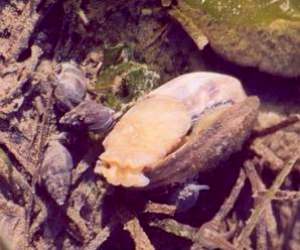
PHOTOS: Bulla quoyii, Beach Rd-Harbour Drive, Tauranga Harbour, New Zealand, July 2003. Photos: Paul Furneaux. Upper right: dead animal plus whelks.
Lower left: Shells. Lower Right: views showing live animal, lateral view (upper), anterior view (middle), animal half extended (lower).
Dear Bill,
Here are some photos of Bulla quoyii that have been quite a challenge to obtain. These animals are apparently quite common in Tauranga Harbour, New Zealand, if their empty shells are anything to go by, but finding and working with living animals is something else again and I have had to resort to using an aquarium to obtain these few shots. They are such shy, reclusive "critters". The headshield and foot is a beautiful honey-gold colour with flecks of a lighter pale colour scattered over it. The leading edge of the headshield is interesting in that at each "corner" there appears to be a fold which is perhaps the forerunner of a more specialised sensitive area/tentacle?
All of the empty shells and live animals (only 5) that I have found have been from the lower intertidal part of the flats, within the region that I have previously described for Aplysia juliana, Pleurobranchaea maculata, Melanochlamys cylindrica, Philinopsis taronga and Haminoea zelandiae. There appears to have been a fairly high death rate among the Bulla population during July - August because the number of "fresh" shells observed has been significant during these months and also the number of "newly dead" animals encountered has also been significant. These "newly dead" animals have a very distinctive pose, upside-down, headshield and foot obvious, and usually with the first few scavengers gathering, mostly Cominella species but the occasional Melanochlamys and Pleurobranchaea have also shown an interest.
I have not come across the egg mass of Bulla thus far but perhaps the season is not yet right. According to Willan and Morton (1984) the eggs are red and should be easy enough to identify once the egg mass is located. (By comparison the egg masses of Haminoea are incredibly numerous at present) The winter months seem to be busy times in terms of sea slug reproduction here in Tauranga, something that I did not expect but perhaps related to predator avoidance or in some way enhancing survival chances for larvae?
• Willan, R. & Morton, J. (1984) Marine Molluscs. Part 2. Opisthobranchia. Leigh Marine Laboratory, University of Auckland, New Zealand.
Regards,
Paul Furneaux.
P.Furneaux@xtra.co.nz


Thanks Paul,
As you have found, there can be huge banks of dead shells, but little sign of live animals. Concerning the apparent increase in reproduction during winter months, we certainly need more long-term studies like yours to see what is going on. One important point to take into account is the availability of food. In New Zealand and parts of Australia, summer months are when the lowest tides occur during daylight hours, and so coincide with the hottest times of the year. This is not a good time for intertidal animals, especially on intertidal sand and mudflats, when even the water in shallow pools is likely to 'cook' the animals. It is also not a good time for many algae, especially the filamentous greesn and Ulva which herbivorous cephalaspideans feed on.
Best wishes,
Bill Rudman
